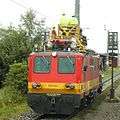Austrian Federal Railways
|
| |
| Aktiengesellschaft | |
| Industry | Transport |
| Predecessor |
Imperial Royal Austrian State Railways Austrian Southern Railway |
| Founded | 1923 (refounded 1947) |
| Headquarters | Vienna, Austria |
Area served | Central Europe |
Key people | Christian Kern |
| Products | Rail transport, Cargo transport, Services |
| Revenue |
|
|
| |
|
| |
Number of employees | 39,513 (2013) |
| Divisions |
|
| Website | www.oebb.at |
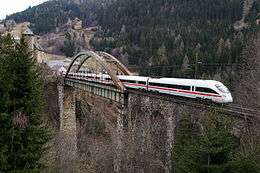

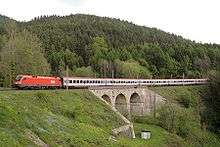

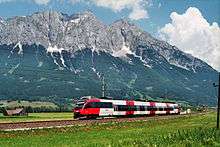

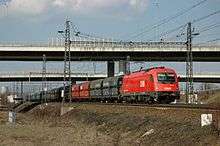

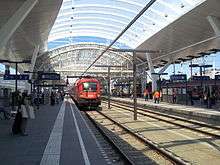


The Austrian Federal Railways (German: Österreichische Bundesbahnen or ÖBB, formerly the Bundesbahn Österreich or BBÖ) is the national railway system of Austria, and the administrator of Liechtenstein's railways. The ÖBB group is owned entirely by the Republic of Austria and is divided into several separate businesses that manage the infrastructure and operate passenger and freight services.
The Austrian Federal Railways has had two discrete periods of existence. It was first formed in 1923, using the Bundesbahn Österreich name, as a successor to the Imperial Royal Austrian State Railways (kkStB), but was incorporated into the Deutsche Reichsbahn during the 1938-1945 Anschluss. It was reformed in 1947, using the slightly different Österreichische Bundesbahnen name, and remains in existence in this form.
Major changes currently being made to the Austrian railway network are the construction of the Wien Hauptbahnhof (Vienna main station), the Koralm Railway, the Semmering Base Tunnel and the Brenner Base Tunnel connection with Italy.
History
- 1882 – Gradual nationalisation of the railway network of the Austro-Hungarian Empire into the Imperial Royal Austrian State Railways (Kaiserlich-königliche österreichische Staatsbahnen, kkStB). By the outbreak of the first world war, the only major railway in Austria to remain in private hands was the Austrian Southern Railway (Südbahn).
- 1918 – After the break-up of the Austro-Hungarian Empire following the first world war, the Austrian rump of kkStB remained in state control under the name Deutschösterreichische Staatsbahnen (DÖStB), which was renamed the Österreichische Staatsbahnen (ÖStB) in 1919.
- 1923 – Foundation of the independent, commercial enterprise, the Bundesbahn Österreich (which used the abbreviation BBÖ, because ÖBB was already taken by the Swiss Oensingen-Balsthal-Bahn). This company took over the assets of the ÖStB and the Südbahn, together with other minor railways.
- 1938 – The Anschluss of Austria into the German Empire. The BBÖ was taken over by the Deutsche Reichsbahn. During the Second World War about 41% of the Austrian railway network was destroyed.
- 1947 – The company was reformed using the slightly different name of Österreichische Bundesbahnen and the abbreviation ÖBB (by that time the Swiss private railway used the abbreviation SP for its goods wagons in international traffic, so its abbreviation ÖBB could now be appropriated) as a state-owned company. Their infrastructure was rebuilt and electrification was accelerated.
- 1969 – A new federal railway law was enacted. The ÖBB became a non-independent, economic entity, that was run as a branch of the government's industrial programme and remained entirely within the Federal budget.
- 1992 – The ÖBB were broken out of the federal budget and turned into company with its own legal status (a cross between a GmbH and an AG in Austrian commercial terms). The company is 100% owned by the Republic of Austria. This change had two primary aims: 1. It had to conform to EU rules on the admission of Austria into the European Union. 2. The financial demand on the public purse was to be reduced as a result of improvements in efficiency and the pressure of competition.
- 2004 – The ÖBB were reorganised into ÖBB Holding AG and a number of operating subsidiaries. The holding company was to oversee the operations of the companies assigned to it, coordinate a coherent strategic approach and allocate tasks for the whole enterprise.[2]
- 1 January 2005 – The subsidiaries of ÖBB-Holding AG became autonomous and independent operationally. See below.
The Austrian rail system is largely electrified. Electrification of the system began in 1912 but did not reach an advanced state until the 1950s. The last steam locomotive in regular service on the standard gauge network was retired in 1978.
The post-war laws related to the Austrian railways were the:
- Eisenbahngesetz (EisbG 1957),
- Schieneninfrastrukturfinanzierungsgesetz (SCHIG 1999),
- Eisenbahnhochleistungsstreckengesetz (HIG 1999) and
- Bundesbahngesetz (1992).
The various logos of the ÖBB over time
-

Starting with the oldest, which is a classic "flying wheel" as used in different variants by many railway companies around the world...
-

...a more modern one introduced in the 1970s...
-

... to the latest one, where the shape of the initial Ö is suggestive of the power/on/off symbol now used on many electronic devices.
Current structure
By a law of August 2009, the organisational structure dating from 2005 was further modified; the railways are under the control of ÖBB-Holding AG, a holding company wholly owned by the Austrian state, under the Bundesministerium für Verkehr, Innovation und Technologie.[3]
The holding company has (2014) a number of subsidiaries[4]
Operating subsidiary:
- ÖBB-Personenverkehr AG (Passenger transport)
- ÖBB-Postbus GmbH, 100% subsidiary
- ÖBB-Produktion GmbH, 50% subsidiary
- ÖBB-Technische Services GmbH, 49% subsidiary
- ÖBB Rail Tours|Rail Tours Touristik GmbH, 100% subsidiary
- Rail Cargo Austria AG (RCA) (Freight transport)
- Rail Cargo Hungaria Zrt., 100% subsidiary
- ÖBB-Produktion GmbH, 50% subsidiary
- ÖBB-Technische Services GmbH, 51% subsidiary
- Rail Cargo Logistics - Austria GmbH
- ÖBB-Infrastruktur AG (Infrastructure planning, management, and construction)
- ÖBB-Immobilienmanagement GmbH, 100% subsidiary
- Mungos Sicher & Sauber GmbH, 100% subsidiary
- Rail Equipment GmbH, 100% subsidiary
Subsidiary companies of ÖBB-Holding AG:
- ÖBB-Shared Service Center GmbH 100% subsidiary
- ÖBB-IKT GmbH 100% subsidiary
- ÖBB-Werbung GmbH 100% subsidiary
- European Contract Logistics - Austria GmbH 100% subsidiary
Subsidiary companies of ÖBB-Personenverkehr AG and Rail Cargo Austria AG are:
- ÖBB-Produktion GmbH (provision of locomotives)
- ÖBB-Technische Services GmbH (technical services)
Infrastructure
The infrastructure of the state-owned Austrian network is managed by ÖBB-Infrastruktur AG, which was formed from former infrastructure-related units including Brenner Eisenbahn GmbH. It now manages 9,740 km of track, 788 signal boxes, 247 tunnels, 6,207 bridges and eight hydro-electric power (hep) stations for the 16.7 Hz electrification system, and two hep stations for 50 Hz power generation.
At the end of 2009 it employed 17,612 staff.[3]
| Österreichische Bundesbahnen | |
|---|---|
| Sales | Infrastructure |
| Passenger transport | Network |
| Freight transport | Tracks |
| Traction | Signal-/System technology |
| Technical services | Telekom |
| Power plants | Energy network |
| Facility management | Planning/Engineering |
| Facility management | |
Statistics
According to the Annual Report 2013, the company employs 39,513, there of 13,599 employees, 24,251 tenured employees and 1,663 apprentices. In 2013, ÖBB-Personenverkehr AG carried 469 million passengers of which 235 million were bus passengers.[5] The ÖBB has
- 4,859 km (3,020 route miles); 72% electrified
- 1,128 train stations
- 1,093 locomotives.
- 2,799 passenger vehicles
- 26,518 freight wagons
- 2,200 busses
- ÖBB's bus services travel 52,500,000 km (32,621,988 mi) per year.
Principal Lines
- Western Railway from Wien Westbahnhof via St. Pölten Hauptbahnhof and Linz Hauptbahnhof to Salzburg Hauptbahnhof, including a parallel high-speed rail section ("New Western Railway") from Wien Meidling railway station to Linz
- Southern Railway from Wien Hauptbahnhof (under construction)/Wien Meidling to Graz Hauptbahnhof, including the Semmering railway section - a UNESCO World Heritage Site
- continuation to Klagenfurt by the Koralm Railway (under construction)
- Northern Railway from Wien Praterstern railway station to Břeclav, Czech Republic
- Eastern Railway from Vienna Hauptbahnhof (under construction) to Hegyeshalom, Hungary and Budapest Keleti railway station
- Emperor Franz Joseph Railway from Wien Franz-Josefs-Bahnhof to Gmünd, Lower Austria and České Velenice, Czech Republic
- Salzburg-Tyrol Railway from Salzburg Hauptbahnhof to Wörgl Hauptbahnhof
- Enns Valley Railway from the Salzburg-Tyrol Railway at Bischofshofen to Selzthal
- Tauern Railway from the Salzburg-Tyrol Railway at Schwarzach/Sankt Veit to Spittal an der Drau via the Tauern Railway Tunnel
- Lower Inn Valley Railway from the German border near Kufstein railway station via Wörgl Hauptbahnhof to Innsbruck Hauptbahnhof; to be relieved by the New Lower Inn Valley railway line (under construction), part of the Trans-European Berlin–Palermo railway axis
- western continuation by the Arlberg Railway to Bludenz railway station via the Arlberg Railway Tunnel
- northwestern continuation by the Mittenwald Railway to Garmisch-Partenkirchen, Germany and the Ausserfern Railway to Kempten Hauptbahnhof
- southern continuation by the Brenner Railway to Bolzano, Italy and Verona via the Innsbruck bypass and the Brenner Pass, to be replaced by the Brenner Base Tunnel (planned)
Rail links to adjacent countries
All neighbouring railways have the same gauge.
- Czech Republic — voltage change to 25 kV 50 Hz AC
- Germany — same voltage 15 kV AC
- Hungary — voltage change to 25 kV 50 Hz AC
- Italy — voltage change to 3 kV DC
- Liechtenstein — same voltage 15 kV AC
- Slovakia — voltage change to 25 kV 50 Hz AC
- Slovenia — voltage change to 3 kV DC
- Switzerland — same voltage 15 kV AC
Active Rolling Stock
Electric Locomotives
-
ÖBB Class 1016/1116/1216 Taurus
Diesel Locomotives
-

ÖBB Class 2016 Hercules
-

ÖBB Class 2070 Hector
-

ÖBB Class 2080/2081 Rotary Snow Plough
Electrical multiple units
-

ÖBB Class 2023/2024/2124 Talent
Diesel Railcars
-

ÖBB Class 5022 Desiro
Maintenance of way equipment
See also
|
Other railways in Austria
References
- 1 2 3 "(untitled)" (PDF). ÖBB.
- ↑ ÖBB-Holding AG. "Aufgaben".
- 1 2 Richter, Karl Arne, ed. (2010). Europäische Bahnen '11. Hamburg: Eurailpress. ISBN 978-3-7771-0413-3.
- ↑ "Organigramm". ÖBB. 3 March 2014.
- ↑ "Daten & Fakten". ÖBB.
External links
| Wikimedia Commons has media related to Österreichische Bundesbahnen. |
- Austrian Federal Railways website
- International relations UIC
- International relations CER
- report of audit court 2006
- modification of railroad law 2004
- passenger traffic tariffs of ÖBB in 2008
- Winchester, Clarence, ed. (1936), "Austria's rail transport", Railway Wonders of the World, pp. 971–977, illustrated account of Austrian railways in the 1930s.
| ||||||||||||||||||||||||||
| ||||||||||||||||||||||||||||||
| ||||||||||||
| ||||||||||||||

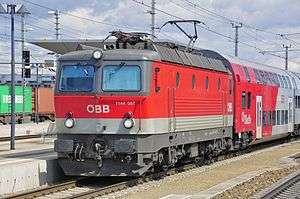





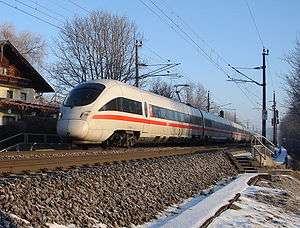






.jpg)
